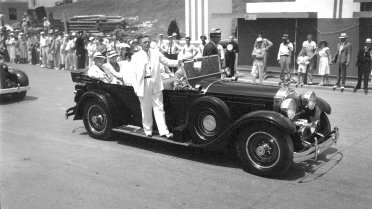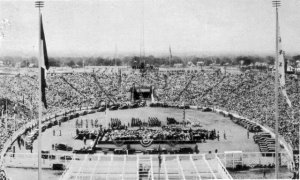|

Return to: Texas Centennial Exposition Index
FDR's Visit
 Aside from the opening day ceremonies, perhaps the most exciting event of the 1936 Centennial Exposition was the visit of President Franklin D. Roosevelt on Friday, June 12. It was an election year and FDR's visit was part of a pre-campaign swing through the South. By chance, the visit also coincided with the nomination of Alf Landon as Republican candidate for President, occuring that same day in Cleveland, Ohio. Aside from the opening day ceremonies, perhaps the most exciting event of the 1936 Centennial Exposition was the visit of President Franklin D. Roosevelt on Friday, June 12. It was an election year and FDR's visit was part of a pre-campaign swing through the South. By chance, the visit also coincided with the nomination of Alf Landon as Republican candidate for President, occuring that same day in Cleveland, Ohio.
At 9:30 a.m., President Roosevelt arrived in Dallas by train at Union Terminal. Crowds of Dallasites watched from the Houston Street Viaduct as he disembarked and, along with his wife Eleanor, seated himself in the back of an open touring car for the three mile ride to Fair Park.
 Main Street was jammed with people lining the route, hoping for a glimpse of the popular President and his equally popular First Lady. Many stores along the route were closed, as it seemed pointless to remain open with all the customers outside on the curb. It wasn't every day that the President of the United States came to town. As the Presidential motorcade made its way through downtown Dallas Roosevelt's heart must have been gladdened by the tumultuous response his presence aroused. All along the way people waved and cheered and ticker tape and torn paper rained from upper-storey office building windows. Main Street was jammed with people lining the route, hoping for a glimpse of the popular President and his equally popular First Lady. Many stores along the route were closed, as it seemed pointless to remain open with all the customers outside on the curb. It wasn't every day that the President of the United States came to town. As the Presidential motorcade made its way through downtown Dallas Roosevelt's heart must have been gladdened by the tumultuous response his presence aroused. All along the way people waved and cheered and ticker tape and torn paper rained from upper-storey office building windows.
At Fair Park, Roosevelt's car entered through the gate by the Auditorium and continued down First Avenue, turning left on Grand, past the Federal Building and the Hall of State and then as twenty-one aerial bombs went off overhead in a Presidential salute, they entered the Cotton Bowl. There, as the Times Herald reported, "one mighty sustained roar went up as the 50,000 persons in the stadium saw the President's car roll down the ramp." On a high, flag-bedecked stage in the center of the cotton bowl, Texas Governor James Allred introduced Roosevelt as "the greatest friend the people of the United States ever had in the White House." The cheers of the crowd left little doubt that there were few in that stadium that would dispute that statement.
 Wearing a white suit, the President stood at the podium and gave a thirty-minute speech, which was broadcast on national network radio. Saluting the "Empire of Texas," FDR took the opportunity to verbally blast monopoly as the "foe of democracy." following his speech the President and Mrs. Roosevelt left the cotton bowl and were taken on a short tour of the exposition. They then left for the Adolphus Hotel, downtown, where they attended a luncheon with local civic leaders and Centennial officials. Wearing a white suit, the President stood at the podium and gave a thirty-minute speech, which was broadcast on national network radio. Saluting the "Empire of Texas," FDR took the opportunity to verbally blast monopoly as the "foe of democracy." following his speech the President and Mrs. Roosevelt left the cotton bowl and were taken on a short tour of the exposition. They then left for the Adolphus Hotel, downtown, where they attended a luncheon with local civic leaders and Centennial officials.
After lunch Roosevelt left the Adolphus for his third and last official function of the day. At Oak Lawn (now Lee) Park, the President was met by yet another adoring and enthusiastic throng.
As the crowd watched and cheered, the President, seated in his car, unveiled a statue of General Robert E. Lee and made a short speech in praise of the Confederate hero.
From there the Roosevelts left Dallas with their son Elliott, driving to his estate near Ft. Worth, where they spent the night. The following morning the Presidential party left for Indiana with the State of Texas figuratively, but nonetheless securely, tucked into the Presidential pocket.
|
Notice: All the images in the Texas Centennial Exposition portion of this website are from materials in my personal collection. Many items have no copyright notice and so far as I know, due to their age those so marked are no longer protected under the copyright laws of the United States. If any person should know otherwise, please notify me at once (texian1846@yahoo.com) so that I may remove any protected item or request permission from the copyright owner to continue to include it. It should be noted that this site is completely non-commercial and no charge is made for viewing it.
|
Photo of FDR in touring car from the Arthur L. Blinick Collection. Used with permission.
This website copyright © 2002-2004 (except where noted) by Steven Butler. All rights reserved.
|

 Aside from the opening day ceremonies, perhaps the most exciting event of the 1936 Centennial Exposition was the visit of President Franklin D. Roosevelt on Friday, June 12. It was an election year and FDR's visit was part of a pre-campaign swing through the South. By chance, the visit also coincided with the nomination of Alf Landon as Republican candidate for President, occuring that same day in Cleveland, Ohio.
Aside from the opening day ceremonies, perhaps the most exciting event of the 1936 Centennial Exposition was the visit of President Franklin D. Roosevelt on Friday, June 12. It was an election year and FDR's visit was part of a pre-campaign swing through the South. By chance, the visit also coincided with the nomination of Alf Landon as Republican candidate for President, occuring that same day in Cleveland, Ohio. Main Street was jammed with people lining the route, hoping for a glimpse of the popular President and his equally popular First Lady. Many stores along the route were closed, as it seemed pointless to remain open with all the customers outside on the curb. It wasn't every day that the President of the United States came to town. As the Presidential motorcade made its way through downtown Dallas Roosevelt's heart must have been gladdened by the tumultuous response his presence aroused. All along the way people waved and cheered and ticker tape and torn paper rained from upper-storey office building windows.
Main Street was jammed with people lining the route, hoping for a glimpse of the popular President and his equally popular First Lady. Many stores along the route were closed, as it seemed pointless to remain open with all the customers outside on the curb. It wasn't every day that the President of the United States came to town. As the Presidential motorcade made its way through downtown Dallas Roosevelt's heart must have been gladdened by the tumultuous response his presence aroused. All along the way people waved and cheered and ticker tape and torn paper rained from upper-storey office building windows. Wearing a white suit, the President stood at the podium and gave a
Wearing a white suit, the President stood at the podium and gave a